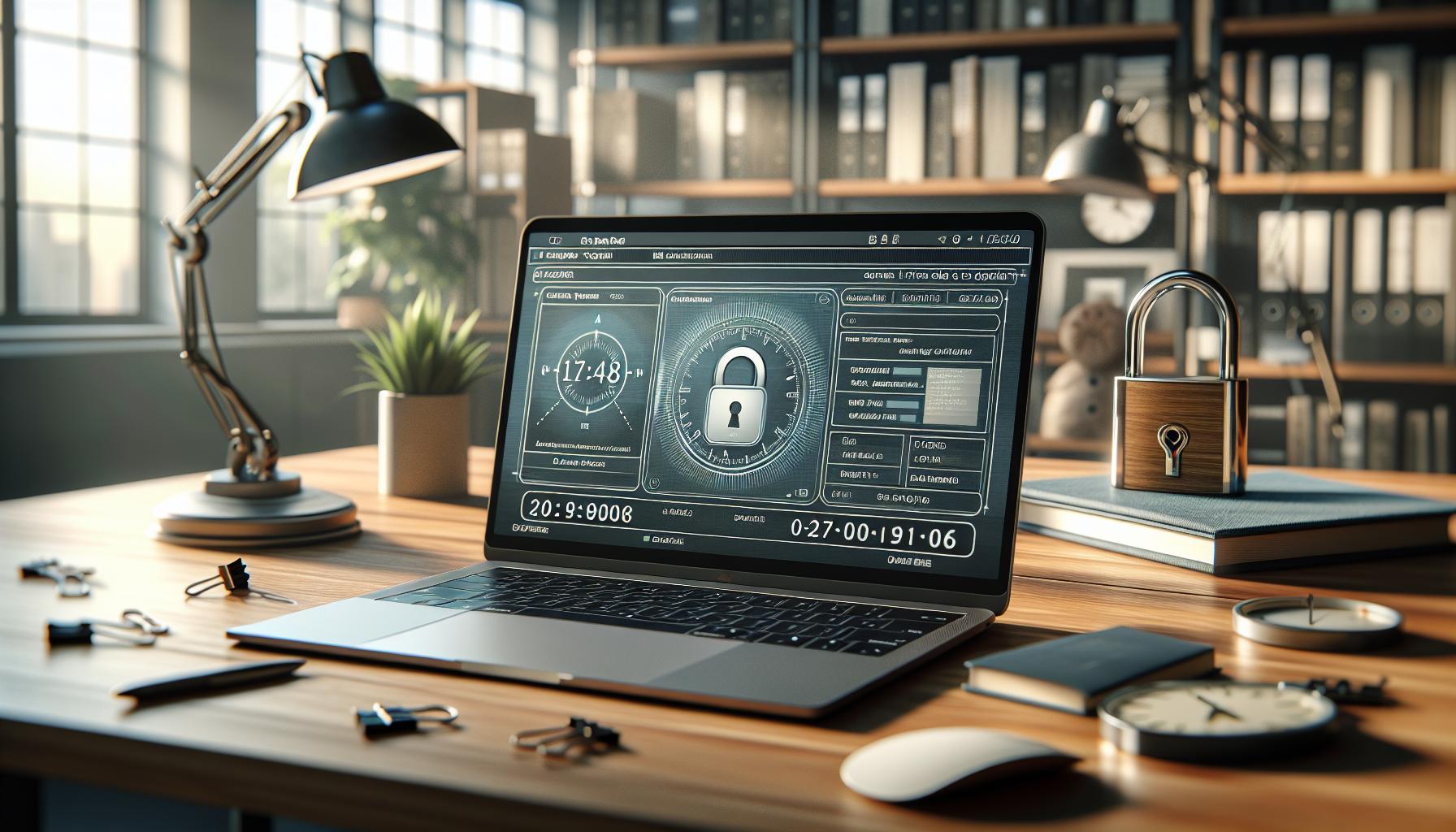Did you know that nearly every digital interaction you have is marked by a precise moment in time? This mark,known as a timestamp,records the exact date and time an event occurs,serving as a crucial digital footprint in everything from emails and social media posts to legal documents and multimedia content. Understanding what a timestamp is and how it works can help you better track,verify,and organize events in today’s fast-paced digital world. Whether you’re managing data for work, securing transactions, or simply trying to navigate lengthy videos and recordings more efficiently, knowing how timestamps function empowers you to make sense of details with clarity and confidence. In this article, we’ll explore the essential definition of timestamps, practical examples of their uses, and why they’ve become indispensable tools for accuracy, accountability, and seamless digital communication. Let’s dive into how this seemingly simple concept plays a vital role behind the scenes of your everyday digital experiences. [3] [1]
What Is a Time Stamp and How Does It Work
Time stamps serve as digital footprints that mark the exact moment an event occurs, offering a precise record of time tied to a specific action or piece of data. Imagine receiving an important email or uploading a critical document-time stamps ensure that the exact time and date of these interactions are captured reliably. This function is crucial not onyl for organizational purposes but also for accountability, helping to track the sequence of events and verify authenticity.
At their core, time stamps work by associating a uniquely identifiable time value-often including date, hour, minute, and second-with data or a digital file. This embedding of time is often automated,relying on system clocks or network time protocols to ensure accuracy. For example, when you take a digital photo, the camera embeds a time stamp within the file metadata, providing a truthful record of when the picture was taken. Similarly, software applications apply time stamps to documents or transactions, making it easy to audit changes or retrieve ancient information swiftly and confidently.
How time stamps operate depends on the system and context, but typically include these key steps:
- Timestamp Generation: The system captures the current time using synchronized clocks to ensure precision.
- Embedding or Attaching: The captured time is embedded into the file metadata or attached as a separate record linked to the data.
- Verification: In some cases, especially for security purposes, time stamps are cryptographically sealed to prevent tampering, creating a trustworthy digital signature.
This mechanism highlights why time stamps are foundational in countless fields-from legal document handling and financial transactions to digital media and content management. For individuals and businesses alike, understanding how time stamps function equips them with a powerful tool to organize, authenticate, and secure their digital interactions efficiently and accurately [[[[[1]](https://www.merriam-webster.com/dictionary/time%20stamp), [[2]](https://trint.com/blog/the-power-of-timestamps).
Different Types of Time Stamps Explained
Time stamps come in various forms,each designed to suit specific needs and technological environments. Understanding these types can definitely help you choose and implement time stamps more effectively, depending on whether you’re managing simple file logging or securing critical legal transactions.
At the most basic level, there are naive time stamps which simply record the local date and time without considering time zones or daylight saving adjustments.These are typically what you see embedded in photos or local file modifications and are easy to generate but lack worldwide context across regions. In contrast, aware time stamps include information about the time zone or offset from Coordinated Universal Time (UTC), making them indispensable for global applications where events must be universally synchronized and easily comparable regardless of location.
When it comes to database and programming contexts, time stamps vary in precision and format. For example, the SQL standard recognizes data types like TIMESTAMP or DATETIME, which store combined date and time values and may support fractional seconds up to nanosecond precision for highly granular tracking of events [3]. Some systems also use TIMESTAMPMS or TIMESTAMPUS to indicate millisecond or microsecond precision respectively, enabling applications to capture events that happen in rapid succession, such as financial trades or telemetry data [1].Another important distinction lies between date-only stamps (datestamps) and date-time stamps.While a datestamp notes only the calendar date (e.g.,”2025-10-30″),a full timestamp includes time-of-day details (e.g., “2025-10-30 14:22:15”), providing an exact temporal marker for events. For many business and security operations, such as legal document timestamps or blockchain transactions, additional cryptographic components are applied to these timestamps to prevent tampering, creating a trusted timestamp that serves as a verifiable proof of when an event occurred.
- Naive Timestamp: Local time with no time zone (e.g., photo metadata).
- Aware Timestamp: Includes time zone info, ideal for global systems.
- Datestamp: Date-only, useful for less granular tracking.
- Date-Time Timestamp: Date combined with precise time and optional fractions of seconds.
- Trusted Timestamp: Cryptographically secured for data integrity and legal use.
- High Precision Timestamp: Supports microsecond or nanosecond precision, common in finance and telemetry.
By selecting the appropriate type of time stamp, organizations can align their data management with their operational requirements-from simple logging and audit trails to legally binding digital signatures and real-time monitoring systems.This nuanced understanding allows businesses and developers to optimize how they capture, store, and verify temporal data reliably.
Common Uses of Time Stamps Across Industries
The precise recording of when an event occurs can make all the difference in many professional environments. Time stamps serve as indispensable tools across numerous industries, providing critical support for everything from operational efficiency to legal accountability. Their capacity to establish an unambiguous timeline means businesses and organizations can track activities, enforce compliance, and improve transparency with confidence.
In the healthcare sector, time stamps are vital for maintaining accurate patient records and ensuring that treatments are administered correctly and promptly. Each medical intervention or test result is recorded with a reliable date and time, which helps in reducing errors and improving patient safety. For instance, documenting the exact moment medication is given can be life-saving and is a standard regulatory requirement.
Financial services heavily rely on high-precision time stamps to monitor trades and transactions. Given the speed at which markets move, the difference of a few microseconds can affect trading outcomes. Time stamps not only support regulatory reporting but also help detect fraudulent activities and maintain trust in financial systems. Likewise, manufacturing industries use time stamps within production lines to optimize workflows, monitor equipment usage, and schedule maintenance, minimizing downtime and increasing productivity.Beyond these, legal and governmental agencies use trusted cryptographic time stamps to authenticate documents and digital contracts. This practice ensures documents cannot be altered unnoticed after a certain point, providing forensic evidence in disputes. Digital timestamping is also pivotal in intellectual property protection, where proving the creation date of content is crucial.
- Healthcare: Patient records, treatment logs, medication administration.
- Finance: trade settlement times, audit trails, fraud detection.
- Manufacturing: Production tracking, maintenance scheduling, quality control.
- Legal & Government: Document authentication, contract verification, compliance audits.
- IT & Cybersecurity: Log file tracking, incident timestamping, change management.
By recognizing how these industries deploy time stamps, organizations can better appreciate the value of integrating precise and secure temporal data into their own systems. Whether it’s meeting regulatory compliance, optimizing business workflows, or enhancing transparency, time stamps play a foundational role in supporting the accuracy and reliability of recorded information.
How Time Stamps Ensure Data Integrity and Security
The assurance that data remains trustworthy and unaltered is essential in today’s digital landscape-this is where time stamps become a powerful ally. By precisely recording when a piece of data or a transaction occurred, time stamps act as digital fingerprints that help verify the authenticity and integrity of information.when embedded correctly, they create an immutable timeline, making it nearly impossible to tamper with records without detection.
At the core of maintaining data integrity is the cryptographic time stamp, which uses advanced encryption to bind a date and time securely to a digital document or event. This process certifies that the data existed in the exact state at a given time, backed by trusted third-party services that act as impartial witnesses. For example, legal departments and intellectual property professionals often rely on such cryptographic verification to prove creation dates of sensitive documents or creative content, offering robust protection against disputes or infringement claims.
- Prevents Post-Event changes: Since the time stamp seals the data at a certain point,any later modification becomes evident,providing a clear audit trail.
- Supports Regulatory Compliance: Industry regulations frequently require verifiable logs; time stamps fulfill this by ensuring records are accurate and unaltered.
- Enhances Security: Time stamps play a crucial role in cybersecurity, where they help validate the timing of log files and incident reports to track unauthorized activity reliably.
Besides cryptographic time stamping, many systems implement synchronized network time protocols to ensure consistency across distributed databases and applications.This synchronization is vital for spotting anomalies, analyzing causes of faults, and responding rapidly to incidents. For instance, in financial trading, where transactions take place at blistering speeds, precise and tamper-proof time stamps help detect fraud and enforce accountability.
Leveraging electronic time stamps also reduces uncertainty and costs associated with disputes and investigations. Organizations can automate timestamping processes within workflows, enhancing transparency without adding overhead. When combined with secure blockchain ledger records or trusted third-party authorities, these time stamps provide a resilient defense against data breaches or manipulation-giving stakeholders confidence in the validity of their information over time[[[[[1]](https://edicomgroup.com/blog/advantages-of-using-electronic-time-stamps-for-your-documents).
reliable time stamping is a foundational pillar for safeguarding data integrity and security. Whether protecting digital contracts, enabling forensic auditing, or supporting real-time incident management, they guarantee that the chronology and authenticity of critical information remain intact and verifiable.
Time Stamps in Digital Communication and Social media
Time stamps serve as crucial anchors in the fast-paced world of digital communication and social media, offering clarity and context in environments where information flows rapidly and often chaotically. Every post, comment, message, or shared media snippet is tagged with a precise moment of creation or modification, providing a temporal framework that helps users track conversations, verify authenticity, and navigate content more effectively. These markers not only improve user experience by establishing a chronological order but also play a pivotal role in moderating discussions and resolving disputes online.
In social media platforms like Twitter, Facebook, instagram, and YouTube, time stamps transform streams of content into cohesive narratives. For instance, on YouTube, creators use timestamps to segment videos into chapters, making it easier for viewers to locate specific topics or moments without sifting through entire videos.This not only enhances engagement but also increases accessibility by enabling users to jump directly to relevant sections. Similarly, in messaging applications, time stamps help users understand the sequence of replies and the freshness of information, which is vital for collaborative projects or customer service interactions [[2]](https://www.castmagic.io/post/how-to-add-timestamps-on-youtube).Beyond user convenience, time stamps underpin critical functions in digital communication security. By pairing messages and posts with precise times, platforms can trace the origins of misinformation, spam, or cyberattacks, facilitating more effective moderation and forensic analysis. For example, during coordinated misinformation campaigns, investigators can analyze time-stamped posts to determine patterns, detect artificial amplification, and establish timelines for counter-measures. Moreover,in legal contexts,time stamps may serve as digital evidence that helps establish when certain statements or transactions were made,reinforcing accountability and transparency.
Practical advice for effectively leveraging time stamps in digital communication involves not only relying on the automatic tagging by platforms but also understanding how to utilize and share these data points.Content creators and community managers should consider highlighting time stamps when linking to specific comments or video segments to improve clarity and engagement. Audiences, on the other hand, can use time stamps to verify the recency and relevance of information, especially in fast-evolving situations like news updates or live events. Embracing time stamps as tools for both navigation and verification promotes a healthier, more transparent digital habitat.
- Improves Clarity and Context: Establishes clear timelines for conversations and content evolution.
- Facilitates Content Navigation: Enables users to jump directly to relevant parts of videos or discussions.
- Supports Digital Security: Assists in tracking misinformation and building evidence for investigations.
- Enhances User Engagement: Makes content more accessible and easier to interact with.
Understanding Time Stamp Formats and Standards
Time stamps might seem straightforward at first glance-a simple date and time label-but beneath this simplicity lies a complex ecosystem of formats and standards that ensure time stamps are universally understood, precise, and reliable. Without consistent formatting, even the most accurate time stamps could lead to confusion, misinterpretation, or data mismatches, especially when coordinating across different time zones or technological systems.
At the core of effective time stamping is adherence to widely accepted standards such as the ISO 8601, which prescribes a clear, unambiguous format: YYYY-MM-DDTHH:MM:SSZ. This notation not only avoids regional date format confusion but also supports time zone indications via the “Z” (Zulu time) or explicit offsets (e.g.,+02:00). Such as, the timestamp “2025-10-31T14:30:00Z” precisely denotes October 31, 2025, at 2:30 PM Coordinated Universal Time (UTC). Employing this format allows systems worldwide-from databases to mobile apps-to synchronize activities and logs seamlessly without misinterpretation.
Exploring the Various Time Stamp Types and Their Uses
Different contexts call for different types of time stamps. While human-readable formats like ISO 8601 are common in logs, displays, and reports, systems often rely on more compact or integer-based timestamps such as Unix epoch time. The Unix epoch counts seconds elapsed since January 1, 1970 (UTC), offering a language-agnostic, efficient format for computations and comparisons. As an example, the integer “1700000000” corresponds to a specific moment in time that systems like databases and servers can process rapidly and uniformly[[[[[1]](https://www.sumologic.com/help/docs/send-data/reference-information/time-reference/).
Practical Tips for Choosing and Using Time Stamp Formats
- Consistency is Key: Use one standardized time format across your system to avoid costly errors and simplify data integration.
- Include Time Zone Information: Always specify the time zone or use UTC to ensure clarity, especially in global applications.
- balance Readability and Efficiency: Use human-readable formats for user interfaces and epoch timestamps for backend processes.
- Validate Inputs and Outputs: Implement rigorous checks so that time stamps follow the expected format, preventing data corruption.
Understanding these standards and formats is not just a technical formality but a practical necessity.In fields like finance, healthcare, and cybersecurity, where exact timing can affect legal outcomes or patient safety, proper timestamp formats underpin trust and accountability.Even within social media and everyday communication,accurate time stamps help verify the integrity and sequence of conversations.
In essence, mastering time stamp formats means mastering the language of time in digital systems-allowing people, devices, and applications to speak clearly and coordinate perfectly with one another across the ever-expanding digital landscape.
How to Create and Apply Time Stamps Effectively
One of the most powerful ways to harness the value of time stamps is by integrating them thoughtfully into workflows and data systems to ensure accuracy, traceability, and efficiency. Picking the right moment to generate a time stamp-for example, instantly upon data creation or modification-is crucial to maintaining data integrity and providing meaningful chronological context. In practice, this often means automating time stamp generation in your applications, databases, or logging mechanisms rather than relying on manual input, which can be error-prone or delayed.When applying time stamps, consider the environment in which they will be used. Systems that operate across multiple time zones should adopt UTC (Coordinated Universal Time) to create a single reference point, avoiding confusion caused by local time variations or daylight saving changes. Embedding time zone information explicitly within the timestamp (such as ISO 8601 format’s “Z” suffix for UTC) further enhances clarity and interoperability among distributed systems. For example, cloud infrastructure frequently enough tags resources with creation and last modification times in UTC to facilitate synchronization and auditing across regions[[[[[1]](https://www.reddit.com/r/Terraform/comments/w1mkp1/timestamp_created_on_modified_on_tags/).
Implementing Best Practices for Reliable Time Stamping
- Automate Generation: Use system clocks and software functions to stamp events at the point of occurrence rather than post-processing to avoid discrepancies.
- Standardize Formats: Adopt a uniform format like ISO 8601 or Unix epoch timestamps-both widely supported and straightforward to parse programmatically.
- Maintain Time Consistency: Synchronize servers and devices using protocols such as NTP (Network Time Protocol) to ensure time stamps across your infrastructure don’t drift apart.
- Integrate With Metadata: Combine time stamps with other relevant metadata (e.g.,user ID,event type) to provide context and improve traceability for audits or debugging.
Examples From Real-World Applications
Consider digital document management systems where version control is key. Each time a document is edited, a new time stamp records the exact update time. This technique is equally vital in healthcare records, where recording precise creation and last modification times can have legal and safety implications. developers often implement these by extending classes with creation and update timestamp fields in databases or object-relational mapping layers, ensuring the event times are automatically recorded and available for queries [[2]](https://stackoverflow.com/questions/221611/creation-timestamp-and-last-update-timestamp-with-hibernate-and-mysql).
In programming environments or server logs,Unix epoch timestamps serve as a compact and language-agnostic format. For example, using the number “1700000000” represents a fixed point in time that all systems can interpret identically regardless of locale or programming language nuances[[[[[3]](https://www.unixtimestamp.com/).
Ultimately, creating and applying time stamps effectively is less about the complexity of the timestamp itself and more about embedding them seamlessly and consistently into the data lifecycle. clear policies, standardized tooling, and automated systems transform time stamps from mere labels into vital assets that enforce accuracy, traceability, and security across digital operations.
Challenges and limitations of Using Time Stamps
Time stamps are invaluable tools for recording when events occur, but they aren’t without their challenges. One notable limitation stems from the dependency on accurate and synchronized system clocks.Even slight discrepancies between devices-such as unsynchronized server clocks or user devices set to incorrect times-can lead to inconsistent or misleading time stamping, ultimately compromising data integrity. Such as, in distributed systems spanning multiple geographic locations, without rigorous time synchronization protocols like NTP (Network Time Protocol), time stamps may not reliably reflect the true sequence of events, complicating audit trails or debugging efforts.
Another challenge lies in the choice and implementation of time stamp formats. While standards like ISO 8601 or Unix epoch time make interpretation more consistent, there can be ambiguity if time zone information is omitted or improperly handled. This can cause confusion, especially in cross-border applications or multi-time zone workflows. Additionally, legacy systems using 32-bit Unix timestamps face the notable “Year 2038 problem,” where the maximum representable date overflows, potentially causing software failures or incorrect time stamps after january 19, 2038. Addressing this requires transitioning to 64-bit time representations or alternative methods,which can be complex and resource-intensive in existing infrastructures [[2]](https://konstantinmb.medium.com/the-unix-timestamp-ticking-time-bomb-navigating-the-2038-challenge-99879dca47a1).
Security is another important consideration. Time stamps can be tampered with or forged, especially in systems lacking cryptographic safeguards. If a malicious actor alters a time stamp, it may undermine trust in logs, contracts, or any system relying on sequential event verification. To mitigate this, integrating cryptographic time stamping methods or blockchain-based time stamping can enhance tamper resistance and audit reliability.
- Synchronization issues: Systems must maintain accurate, network-wide time synchronization to ensure reliable time stamps.
- Format and interpretation errors: Omitting time zone details or relying on deprecated formats can lead to confusion and errors.
- Scalability and future-proofing: Problems like the 2038 unix timestamp overflow require proactive system updates.
- Security vulnerabilities: Without cryptographic protection, time stamps might potentially be vulnerable to tampering or falsification.
In practice, anticipating these limitations means adopting comprehensive strategies that include enforcing synchronized clocks, selecting unambiguous time stamp formats with time zone awareness, and implementing robust security measures. While time stamps are foundational for maintaining order and chronology in digital systems, understanding their constraints helps organizations avoid costly errors and reinforces trust in time-based data.
The Future of Time Stamping Technology and Trends
Accurate and trusted time stamping is becoming increasingly critical in our fast-paced digital world, where billions of events happen every second. As we move forward, the technology underpinning time stamps is evolving to meet demands for greater precision, security, and interoperability across diverse systems.One of the most promising trends is the integration of blockchain and distributed ledger technologies to create immutable, cryptographically secured time stamps. This innovation not only ensures that recorded times cannot be altered retrospectively but also opens up new possibilities for trustless verification in industries such as finance,supply chain management,and digital rights management.
Advancements in Synchronization and Precision
Improved synchronization methods are another key development shaping the future of time stamping.Traditional protocols like NTP (Network Time Protocol) have served well but are being complemented by more precise solutions such as precision Time Protocol (PTP) and GPS-based timing, which provide nanosecond-level accuracy. This level of precision is essential for cutting-edge applications including high-frequency trading, 5G telecommunications, and scientific research where even microsecond discrepancies can have significant consequences.
Standardization and Interoperability
As systems become more interconnected globally, there is a growing emphasis on adopting universal standards for time stamps to ensure clarity and consistency.Standards like ISO 8601 have laid a solid foundation, but ongoing work focuses on integrating time zone awareness and graceful handling of irregularities such as leap seconds. Efforts to harmonize formatting and metadata around time stamps will help reduce errors in international contexts and facilitate smoother data exchange across platforms and industries.
Practical Tips for Staying Ahead
To keep pace with these trends, organizations should:
- Invest in robust, synchronized clock infrastructure: Incorporate GPS or PTP solutions where precision is critical.
- Adopt cryptographic time stamping: Use blockchain or other tamper-proof methods when security and auditability are priorities.
- Stay current with evolving standards: Regularly update systems to support modern timestamp formats that include time zone and leap second data.
- Plan for scalability and future challenges: address limitations like the Year 2038 problem by migrating to 64-bit or alternative time representations early.
Embracing these technological advances and best practices will help ensure that time stamps continue to serve as reliable cornerstones of digital trust and operational efficiency well into the future.
FAQ
Q: How do time stamps impact digital contract validation and legal processes?
A: Time stamps provide irrefutable proof of when a digital contract was signed, ensuring legal enforceability and traceability. They verify document authenticity and prevent disputes related to timing, enhancing trust in electronic transactions. For best results,use certified digital time stamps compliant with industry standards,as detailed in our section on data integrity.
Q: Why are standardized timestamp formats critically important in global data exchange?
A: Standardized timestamp formats ensure uniform interpretation of date and time across different systems and time zones, avoiding errors in data synchronization. Using formats like ISO 8601 improves compatibility and accuracy in international communication, as discussed in our article’s timestamp formats section. Implementing these standards reduces processing delays and data discrepancies.
Q: How can businesses troubleshoot common issues with inaccurate time stamps?
A: Inaccurate time stamps often stem from misconfigured system clocks or network delays. Businesses should regularly sync devices with reliable time servers using protocols like NTP (network Time Protocol). This proactive maintenance, referenced under time stamp challenges, ensures precise timing critical for auditing and compliance.
Q: When should organizations consider automating their time stamping processes?
A: Automation of time stamping is ideal when handling large volumes of data or transactions to ensure consistent and error-free request. Automated systems reduce manual input, increase efficiency, and enhance security, especially in industries covered under common uses in our main article. Consider integrating time stamping software to streamline workflows.
Q: What role do time stamps play in blockchain and cryptocurrency transactions?
A: Time stamps in blockchain verify the exact moment a transaction is recorded on the ledger, ensuring transparency and immutability. They prevent double-spending and fraud by chronologically ordering transactions-details foundational to data security as outlined in our timestamp security section.Understanding this can guide businesses exploring blockchain integration.
Q: How can users visually identify time stamps in multimedia editing software?
A: In multimedia tools, time stamps appear as markers showing when specific audio or video events occur, helping editors synchronize and annotate content precisely. This visual cue links content to exact moments, enhancing workflow efficiency – an aspect linked to our explanation of time stamps in digital communication.
Q: What are the best practices for preserving time stamp data integrity over long-term storage?
A: To preserve time stamp integrity, use cryptographic hashing and backup multiple timestamp logs in secure environments. Regular audits and timestamp renewal (re-timestamping) protect against data tampering or loss, principles detailed under security in our article. Employing these techniques ensures reliable historical records.
Q: Where can developers find reliable resources and APIs for implementing digital time stamps?
A: Developers can access trusted APIs and toolkits from providers like DigiStamp, which offer software services for hash generation and secure time stamping. These resources simplify integration, enhance security, and comply with industry standards, complementing the guidance found in our “How to Create and Apply Time Stamps” section. Exploring these tools can improve your project’s reliability.
—
Explore these FAQs to deepen your understanding and maximize the practical benefits of time stamps. For more insights, revisit the sections on formats, security, and application techniques in our main article.
Insights and Conclusions
Understanding the importance of time stamps can streamline how you track,verify,and organize digital information across various platforms. Whether you’re managing content updates, legal documents, or multimedia files, leveraging accurate time stamps enhances transparency and accountability. If you’re ready to deepen your knowledge, explore our guide on how digital signatures complement time stamps or learn about effective methods for document verification.
Don’t miss out on optimizing your workflow-subscribe to our newsletter for the latest insights on time management tools and related technologies. Have questions or unique experiences with time stamps? Share your thoughts in the comments below to join a growing community of informed professionals.By continuously exploring topics like timestamp usage, metadata, and data integrity, you can ensure you stay ahead in managing digital records efficiently and securely.









